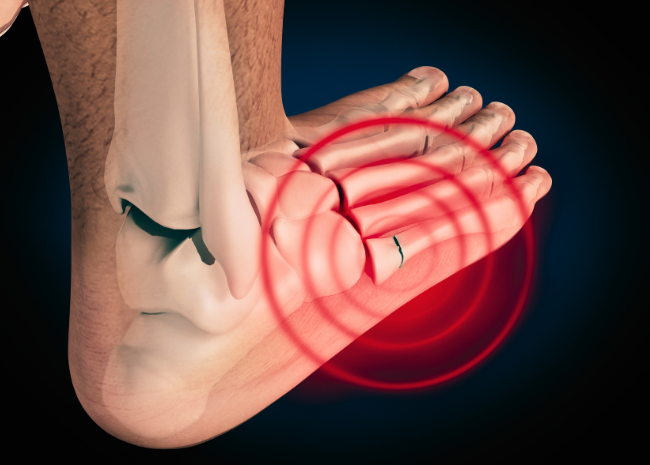
Understanding Fifth Metatarsal Avulsion Fractures: Putting Your Foot in It
So, you might have stubbed your toe or injured your foot while playing sports, and now your doctor is talking about a fifth metatarsal avulsion fracture. What does that even mean?
Let’s break it down.
What is a Fifth Metatarsal Avulsion Fracture?
A fracture is a break in the bone, and your fifth metatarsal is the long midfoot bone on the side of your “pinky” toe.
Now, focus on the fifth metatarsal.
This bone is one of the five long bones that run through the midfoot, and it’s located on the outer side of your foot—right next to your little toe (or “pinky” toe). Think of it as the bone that runs alongside the toe that’s farthest from your big toe.
The fifth metatarsal is actually the most commonly fractured bone in the foot. This is partly because it’s on the outer edge and thus more exposed to impacts and twisting motions, especially in activities like running, jumping, or even just stepping awkwardly.
Types of Fifth Metatarsal Fractures
There are a few types of fractures that can affect the fifth metatarsal:
- Jones Fracture: Usually affects athletes and occurs in a particular spot that receives limited blood supply.
- Stress Fracture: Results from repeated impact to a specific area, causing a hairline break to develop over a relatively long time.
- Avulsion Fracture: Sometimes called a dancer’s fracture, it happens when an attached ligament or tendon pulls off a small piece of the bone near the base of the metatarsal.
What Specifically is an Avulsion Fracture?
An avulsion fracture, specifically, happens when a ligament or tendon attached to the bone pulls off a small piece of it.
It’s like if you were to yank on a small part of a stick, causing a splinter to break off.
In the case of the fifth metatarsal, this often happens near the base of the bone, where the ligaments and tendons are anchored.
Treatment and Recovery
The good news is that most metatarsal fractures heal well if treated properly and promptly.
Treatment of your fifth metatarsal avulsion fracture begins with ascertaining if you can still evert your foot (turn it outward and roll it toward the pinky toe side).
If you can, you have not suffered bone displacement, meaning the fracture can most likely be managed conservatively, without surgery.
Here’s what the treatment typically involves:
Initial Treatment
First things first: reducing pain and swelling.
- Apply Ice: Use ice to reduce pain and swelling.
- Take Anti-Inflammatory Medication: This helps manage pain and inflammation.
- Wear a Therapeutic Immobilizing Boot: You’ll need to use this for about six weeks to keep the foot stable and aid healing.
Rehabilitation
Following the immobilization period, a series of rehabilitation exercises will be designed to rebuild your foot’s strength and range of motion.
An exercise program can make the difference between future proper foot function and possible long-term complications, such as chronic pain, malunion (improper healing of the fracture), and instability.
Such exercises may include:
- Gentle Stretching: Such as “drawing” the alphabet with your big toe, for range of motion.
- Towel Curls: In which you sit in a chair, with your heel on the ground, and use only your toes to reach for a towel just in front of you.
The Importance Of Physical Therapy
Physical therapy is key here.
It’s not just about doing these exercises but also about preventing long-term issues like chronic pain or improper healing.
Your physical therapist will assess your condition and craft a personalized treatment plan that might also include:
- Range of Motion Exercises: Like gentle ankle circles and toe stretches.
- Strengthening Exercises: Such as toe raises, heel-to-toe walks, and resistance band exercises.
- Balance and Proprioception Exercises: These help with stability and might include single-leg standing and balance board exercises.
Did you know you have Direct Access* to Physical Therapy? No referral, no problem!
Seeking Help
If you’ve had a serious foot injury, it’s important to get medical help right away.
Prompt treatment and a well-designed rehab program are crucial for a full recovery.
At The Jackson Clinics, our experienced team specializes in treating foot and ankle injuries, including metatarsal fractures.
We’ll work closely with you to develop a personalized plan and help you get back to the activities you love.
Check out out our 18 Northern Virginia locations to get started today!

















